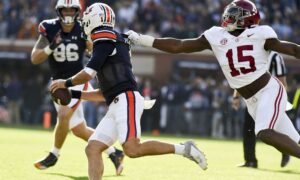Dynasty Capsule: Arizona Cardinals
Every year we give our premium content members a team-by-team, player-by-player look at the NFL season that was. The coverage will be in-depth, but because the Dynasty Capsule series begins immediately after the season, we won’t use it to discuss free agency or the draft. Come see us in early May once Mr. Irrelevant is off the board for another 32-article series giving you the same detailed discussion you’ll see below.
Buckle up dynasty fans, because you’re about to be reminded why our motto is, “There is no off-season.”
Quarterback
Josh Rosen (JAN ADP: 188.83, QB24)
Fellow DLF writer Bobby Koch (@RekedFantasy) recently wrote up a great spotlight on Josh Rosen and his potential heading into 2019 and beyond. One of the fundamental problems with the Cardinals offense last season was their offensive line and their inability to give Rosen time to develop his reads, as Bobby notes. The Cardinals are not one piece away, but they have the luxury of picking number one overall. While defense is also a strong need, the Cardinals would be wise to trade back and acquire pieces to build their offensive line, first and foremost.
Looking at Rosen specifically, his DLF ADP for January sits the lowest of all of the top five rookie quarterbacks from 2018. Baker Mayfield (QB7), Lamar Jackson (QB9), Josh Allen (QB15), and Sam Darnold (QB19) all have passed Rosen in regards to ADP. This isn’t terribly surprising, as Rosen had by far the worst statistical season of any of the aforementioned quarterbacks. With recency bias being a real thing, even in regards to long-term developmental quarterbacks, there’s definitely a buying window open for the young Cal product.
[am4show have=’g1;’ guest_error=’sub_message’ user_error=’sub_message’ ]
Once again circling back to Bobby’s article (it was a good one, check it out!), Rosen’s “best-case” scenario would be a Matthew Stafford type career progression. Comparing Expected Points Added per Attempt for each player’s rookie season, it’s clear to see the parallels. Both were young, 21-year-old first round picks and struggled mightily. However, Stafford’s career progressed very well since his poor rookie season (seen below). This next season is make-or-break for Rosen, in my opinion, and I expect him to take a big step forward.

Running Back
David Johnson (JAN ADP: 19.17, RB9)
Before the 2018 season, Johnson was a lock “Big Four” redraft running back – a group that included Todd Gurley, Ezekiel Elliot, and Le’Veon Bell – and a consistent first round dynasty startup pick. While Johnson still managed to post a very, very respectable RB9 finish on the season, it certainly didn’t feel that way. An RB1 on the season, Johnson managed to post just three weeks of RB1 numbers in 2018. A whopping 12 of Johnson’s 16 games saw him finish as an RB2 or worse for fantasy owners (from FFStatistics, below).

The primary reason Johnson finished as an RB1 on the year was because of injuries to other running backs in the league or new players (like Nick Chubb or Aaron Jones) taking over their backfields mid-season. This is why it didn’t feel like David Johnson was a true RB1 in 2018.
It’s no longer 2018, however, and it’s time to put that season aside for the 27-year-old running back. Last season’s Arizona Cardinals team was a complete disaster, and it’s almost fair to question if we should simply disregard it when projecting DJ moving forward. Rosen is due to take a step forward, they have a new coach who may (and should) look to use Johnson more creatively in all aspects of their offense.
While DJ has fallen from the first round of dynasty drafts, owners seem to have a positive outlook for the once-star running back. As the RB9 in dynasty drafts – and at 27 years old – fantasy owners are taking the chance DJ returns to old form on an improved Cardinals offense. In 2018, Johnson only outscored Aaron Jones, Kerryon Johnson, Dalvin Cook, Leonard Fournette, and other younger running backs by less than two fantasy points per game in PPR leagues. Meanwhile, DJ is ahead of all of the aforementioned players in ADP. In order for the age gap to be worth the higher ADP, Johnson needs to improve next season.
Chase Edmonds (JAN ADP: 185.5, RB64)
Edmonds was a popular choice for early rookie drafters in 2018, showcasing the ability to perform well in all aspects of the game in college. After landing on a Cardinals team with one of the best all-purpose running backs in the league ahead of him, Edmonds started slipping to the third and fourth rounds of rookie drafts. At RB64, Edmonds presents a very good value pick as a capable three-down handcuff.
We saw in 2018 – much to the dismay of David Johnson fantasy owners – the Cardinals use Edmonds in a lot of different ways. Behind Theo Riddick, Justin Jackson, and others in January ADP, Edmonds is a good trade target with RB2 upside should Johnson miss time.
Wide Receiver
Christian Kirk (JAN ADP: 82.5, WR31)
Kirk was one of my favorite players in the 2018 draft class. A smaller but dynamic receiver, Kirk checks a lot of boxes you’d like to see in a quality prospect. Specifically, Kirk broke out at Texas A&M very early on in his career at age 18. From DLF’s Peter Howard’s work (visualization from Zeno James), one can see that Kirk’s production was well above expectation in college every season.

Kirk’s 2018 season had ups and downs, much like the Cardinals team as whole this past season. With Josh Rosen struggling to adjust to the NFL game in his rookie year, Kirk’s counting statistics do not jump off the page. From weeks 1-13, before Kirk was placed on IR for the season, he was the WR38 in PPR leagues. For a rookie on the worst passing offense in the league, this is a good sign of things to come.
I recently took a look to see what Kirk’s profile and 2018 season could compare to, and one player stood out as a clear comparison: Jeremy Maclin. The two have uncanny parallels both in their size, athleticism, and draft capital as well as first-year production in the league. Maclin went on to have a very, very solid career. If Kirk is able to develop his skills with Josh Rosen further this off-season, dynasty owners buying in at WR31 will surely reap the rewards of their investment.
Christian "Jeremy Maclin" Kirk will be my number one buy heading into the offseason pic.twitter.com/CV7o0ZLGvW
— Michael Zingone (@FFzinger) December 3, 2018
Larry Fitzgerald (JAN ADP: 202.75, WR78)
A sure-fire future Hall-of-Famer, Fitz has decided to give it (at least) one more season with the Cardinals. Having signed a one-year deal back in January, Fitzgerald clearly doesn’t want to leave the franchise in a state of chaos after earning the NFL’s 1.01 draft pick.
On paper currently, Fitzgerald is their WR1/2 depending on how much of a step forward Kirk takes in 2019. However, the Cardinals are likely to bring in another weapon sometime in March or April. There isn’t much that needs to be said of Fitzgerald’s dynasty value. One has to work under the assumption that he is only playing for one more season, and we should not expect anything more than WR3 production out of the veteran playmaker. He is solid depth for contending teams and should be sold for a later draft pick for any rebuilding rosters he may be on.
Chad Williams (JAN ADP: N/A)
A once popular sleeper in his own right, Williams failed to live up to any sort of expectations he had this season as the Cardinals WR2/3. While a third-round NFL draft pick just a few years ago, Williams is likely out of the league before given another shot to see fantasy-relevant volume. Catching just 37% of his targets, Williams was both inefficient and ineffective which is a lot to say considering the team he played for. He’s droppable for most rookies coming into the league, even in deep rosters. The Cardinals will definitely bring in competition for his playing time.
Tight End
Ricky Seals-Jones (JAN ADP: 234.25, TE33)
It seems that the whole Cardinals team was filled with popular sleeper picks, looking back on it. RSJ just couldn’t seem to propel himself to even usable tight end status in 2018, which wasn’t particularly difficult to do. In an offense that was failing to move the ball downfield, RSJ was limited to just one touchdown on the year and only eclipsed 40 yards receiving in three games.
Ultimately, tight end fantasy production is based heavily on opportunity. In this fact lies hope for RSJ heading into 2019. In 2018, no tight end who had 72 targets or more finished below TE15 on the season. This number holds true over history, as TEs with 80 or more targets are near locks to finish as TE1s that season. Ricky Seals-Jones, who finished as TE29 on the season, had 70 targets on the year. In that range of TE finishes, Seals-Jones stands out amongst his peers in regards to volume.

As you can see, RSJ had significantly more volume than any of his peers in this TE range. He’s a clear outlier amongst this dataset. Does that mean RSJ is due for positive regression? If he sees another 70-plus targets in 2019, my answer would be yes. However, there’s the obvious chance that RSJ simply just wasn’t good with his opportunity and won’t see the same volume in 2019. On a team without stud pass-catchers, I ultimately expect RSJ to get another chance with this volume. His TE33 price according to January 2019 ADP makes him a strong buy candidate heading into 2019.
With a hopefully improved Rosen and a more creative head coach (he can’t be less creative, right?), this whole Cardinals team has a chance to take a good step forward in 2019. Many of these players have suppressed values in dynasty because of the terrible 2018 season that was for this team. If you’re willing to gamble on Rosen and the new coaching staff getting back to even league average efficiency, there’s a lot of potential upside with these players and others that will get added to this roster throughout the off-season.
[/am4show]
- Week 17 Positional Rankings - January 1, 2022
- Week 16 Positional Rankings - December 23, 2021
- Week 15 Positional Rankings - December 16, 2021

































































